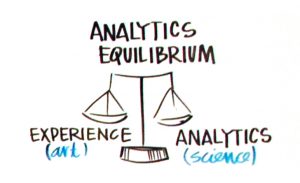 With the current interest in business analytics to help drive decision making, there is considerable discussion about the balance of intuition—good old “gut feel”—and analytics or what I like to call “analytics equilibrium.” This was a topic of discussion at the SAS Power Series held October 11 in New York. The event, which has been held in several cities across the country, gives executives from a broad range of industries an opportunity to discuss some of their analytics challenges with input from thought leader Tom Davenport and SAS’ CMO Jim Davis.
With the current interest in business analytics to help drive decision making, there is considerable discussion about the balance of intuition—good old “gut feel”—and analytics or what I like to call “analytics equilibrium.” This was a topic of discussion at the SAS Power Series held October 11 in New York. The event, which has been held in several cities across the country, gives executives from a broad range of industries an opportunity to discuss some of their analytics challenges with input from thought leader Tom Davenport and SAS’ CMO Jim Davis.
Responding to recent research conducted by Bloomberg Businessweek—which indicates that intuition still trumps analytics in driving decisions—attendees at the session raised the question of finding the right balance between the two, which made me think of this story:
Early in my career, I was a market researcher for a large consumer packaged goods company that produced some of the most popular over the counter remedies in the world. In fact, one product in particular was the subject of a number of memorable commercials, which gave us lines like “Mama mia, that’s a spicy meatball,” “Plop plop fizz fizz,” “Try it, you’ll like it” and “I can’t believe I ate the whole thing.” If you’re old enough, you recognize these phrases and the character “Speedy” from the iconic brand Alka-Seltzer.
While the ads were very popular, Alka-Seltzer market share was slipping in the early 80s—in addition to the product category being flat—and research showed that consumers viewed the brand as old fashioned. After all, the product was 50 years old and the round tablets that fizzle when you drop them in water came in glass tubes. And then there was the taste. You know what I’m talking about.
So the wheels were set in motion to revitalize the brand, including an overhaul of packaging and a focus on improving the taste. As a junior researcher, I spent a good deal of time traveling to focus group facilities and simulated store environments to observe the consumer reaction to new package designs and various attempts to mask the salty flavor of “America’s home remedy”—the product positioning at the time.
When all was said and done (and paid for, of course), the research left us with a dead heat between two package designs. On the flavor front, however, a lemon-lime version had done very well in taste tests.
With the research on package design and the early indication that we were on to something with the new flavoring, I fully expected to be sent out for a “bake off” of the packages and to begin work on selecting test markets for the lemon lime Alka-Seltzer. Instead, during a meeting where the results of the research were presented, the senior marketing executive picked up one of two package prototypes that had tested the best and said, “Let’s go with this one.” He also decided to skip any further testing on the lemon-lime favor and go straight to a nationwide rollout.
This is one of my favorite stories about combining the use of data and “gut feel.” I learned that ultimately it wasn’t just about the data. The extensive analytics mixed with a strong dose of senior management experience led to the successful revitalization of the Alka-Seltzer brand in the 1980s.
Organizations these days that are successful despite relying solely on intuition are, quite frankly, just plain lucky. On the other hand, analytics will never completely replace intuition. Businesses can’t be run by data alone. Intuition—sometimes just in the form of “good common sense”—will always be needed in the decision process. So the bottom line: there is no one perfect ratio of intuition to analytics. Organizations must find their own analytics equilibrium. What works will depend on a number of factors: data quality and management, infrastructure, analytical sophistication, organizational culture, just to name a few.
In the case of Alka-Seltzer, the executive who stepped in to use his intuition on the final product packaging and taste let the analytics guide the decision just so far. Then he relied on his 20 years of experience with the brand to make the final call. No, it wasn’t a game changing strategic decision. But Alka-Seltzer, now an 80 year old brand, is still a staple in my medicine cabinet, and I’m guessing it’s in yours too.
